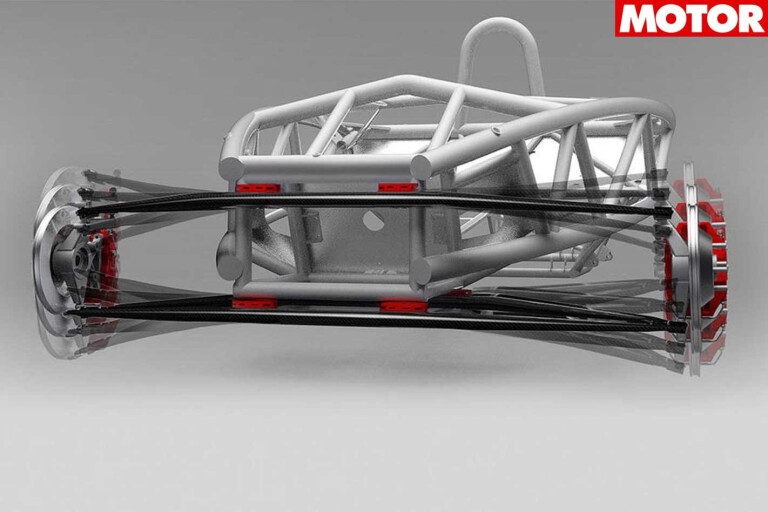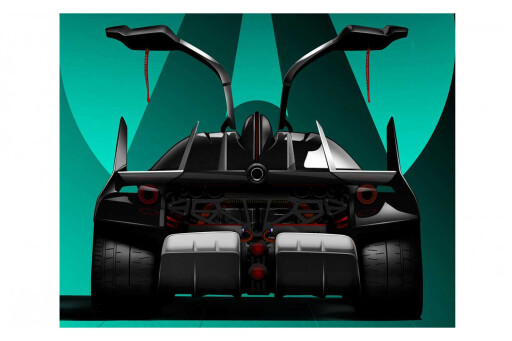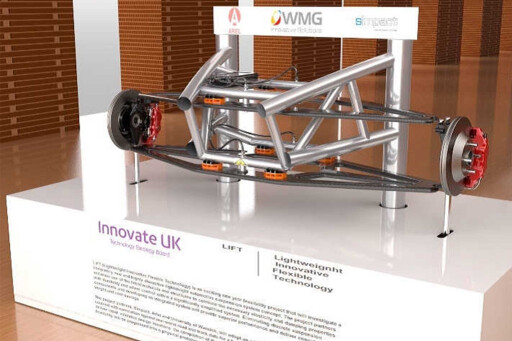
Engineers have wrung a remarkable amount out of the internal combustion engine.
Dry-sump systems have banished oil surge, variable valve lift has broadened power bands, while turbo and superchargers have sent outputs soaring. However, the electric motor will wipe those advancements if people like Elon Musk get their way. As a propulsion unit, they’re simpler and more efficient.
Yet, revolutionary change isn’t on the horizon just for means of propulsion. The coils under your guards are set for the same fate if Simpact, a small UK engineering consultancy, gets its way with a radical rethink on suspension. Its idea, ultimately, is to junk bushes, roll bars, dampers, and springs for a flexible wishbone.
 Made from intricately woven fibres of varying thickness, the arms are said to absorb the impacts the other components would as a team, while controlling wheel movement. This could represent the most dramatic leap forward in suspension design in recent years, as the system is claimed to slash almost 50 per cent of mass on a conventional setup.
Made from intricately woven fibres of varying thickness, the arms are said to absorb the impacts the other components would as a team, while controlling wheel movement. This could represent the most dramatic leap forward in suspension design in recent years, as the system is claimed to slash almost 50 per cent of mass on a conventional setup.
Partnering with Ariel motor company to develop the technology, the system is said to be able to shed 38 per cent from an Atom’s already featherweight suspension assembly.
This is an incredible achievement as the Atom’s suspension design does not include anti-roll bars, something else the wishbone replaces. There are also massive benefits to service life, with the system claimed to last almost 1,000,000km.
 It’s called LIFT, or Lightweight Innovative Flexible Technology. The idea is Dirk Landheer’s, a mechanical engineer who’s also the managing director of Simpact.
It’s called LIFT, or Lightweight Innovative Flexible Technology. The idea is Dirk Landheer’s, a mechanical engineer who’s also the managing director of Simpact.
“[We wondered] wouldn’t it be fantastic if you could have vehicle suspension that is a little bit like the wings of an eagle, that it organically adjusts itself to the environment it is in,” commercial director Tim Williams tells MOTOR.
Simpact then undertook a one year project to prove such an idea in a digital environment, leaning on Warwick University for numerical modelling. It was a success, but had sceptics.
“We thought if we were going to take this forward, [we would need to] develop it within a new collaborative R&D project into an actual on-vehicle demonstration. We really needed to at least make something to prove the flexible wishbone works.”
A physical rig was built last year to great response. Such that Simpact is currently on the lookout for funding to build a prototype Atom with LIFT, which might later see it installed on the incoming Ariel ‘hyper’ car. Which it says has world-beating potential.
Ariel Hypercar?
In Ariel’s push to be known as more than just an Atom company, it will release an Evora-sized two-seat coupe with an appetite for Porsche’s and Mercedes-AMG’s best.
Known as the P40 in its current concept and development stage, the car is touted to shred 0-160km/h in 3.8sec and is due for production in less than two years. Power is supplied by four electric motors, for 868kW in total and all-wheel drive. It’s torque peak is also said to be a staggering 1801Nm.
 The motors are fed by a high output 42kWh battery, charged by a turbine range extender. As reported by TopGear the turbine delivers 35kW of charging power and spins at 120,000rpm.
The motors are fed by a high output 42kWh battery, charged by a turbine range extender. As reported by TopGear the turbine delivers 35kW of charging power and spins at 120,000rpm.
It will be based around an aluminium monocoque and showcase British manufacturing as much as possible. This is where Simpact will come in. Though Tim Williams wasn’t more forthcoming as to how the LIFT system would present itself on the P40, considering the concept is currently displayed with traditional coilovers.
The British government has poured £2m of funding into the project through the same agency which supported the birth of LIFT.
Five LIFT tidbits
1 - POWER OF PIEZO
The minds behind the project say LIFT will eventually use piezo fibres for improved suspension compliance, fully replacing the role of a damper. Such fibres can adjust their flexibility based on electric current, to further disperse energy and further hone the system’s damping control.
2 - BACK AND FORTH
Suspension systems also have to deal with front and backwards forces, but Dirk Landheer says that’s not a problem. Sensors on a regular Atom amassed data on how its suspension behaves, so engineers could apply that to LIFT. While the design has been proved in simulation tests.
3 - TEST PILOT
 Simpact’s dynamic display at the Cenex-LCV show last September employed a lower suspension blade attached to the front-end of an Ariel Atom chassis rig. Electric motors inside a box then would “articulate the wishbone by a certain displacement”. It’s now set for real roads on an Ariel Atom.
Simpact’s dynamic display at the Cenex-LCV show last September employed a lower suspension blade attached to the front-end of an Ariel Atom chassis rig. Electric motors inside a box then would “articulate the wishbone by a certain displacement”. It’s now set for real roads on an Ariel Atom.
4 - ONE FOR ALL
The system is said to be scalable from light to heavy-duty projects and can be tuned for different characteristics. The team analysed a Toyota Yaris and revealed it could save 46 per cent of mass in the suspension.
5 - CHARGED UP
Considering lightweighting projects in the UK are inspired by an interest in electric vehicles, piezo fibres present the ability to harvest energy from the arm movements. Your cigarette lighter contains piezo crystals and when the button is pressed, they’re ruptured to spark electricity.

COMMENTS